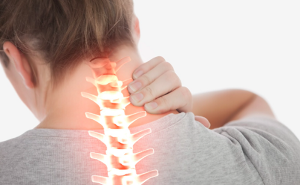
Osteochondrosis is a degenerative disease of the spine that manifests itself in a deformation of the bone tissue and the intervertebral discs.
The first symptoms can appear after 20 to 30 years, but the disease is more common after 40 years. It is divided into three categories - osteochondrosis of the lumbar, thoracic, and cervical spine.
Reasons for development
The causes for the onset and development of cervical osteochondrosis are divided into the following factors:
- hereditary predisposition to the disease;
- metabolic disorders, intoxication of the body, infectious diseases;
- Overweight and increased stress on all parts of the spine, including the cervix;
- lack of fluids, vitamins or microelements, poor nutritional quality;
- spinal injuries, bruises, fractures;
- climatic or environmental conditions that have an adverse effect on the body;
- incorrect posture, curvature of the spine;
- Flat feet, use of high-heeled shoes;
- sedentary, sedentary lifestyle;
- high activity that requires frequent changes in body position;
- frequent physical activity on the spine;
- to remain in an uncomfortable position for a long time;
- Stressful situations, nervous overload.
The occurrence of osteochondrosis is often associated with professional activities. Constant physical activity, high mobility and sedentary work form the main risk group.
Another category of people prone to cervical osteochondrosis is formed due to the objective and external conditions of exposure. Heredity, climate, frequent hypothermia - all this adds to the stress on the spine. This also includes malnutrition and a lack of necessary substances that can prevent osteochondrosis in the cervical spine.
Incorrect sleeping position, prolonged immobility, especially in an uncomfortable position, wearing uncomfortable shoes - all of these form a further risk group. This also includes pregnant women, especially if they have multiple children or an undeveloped musculoskeletal system.
Stages of osteochondrosis development
The development of osteochondrosis is divided into four stages. The first is characterized by the development of the pathology of the nucleus pulposus. Lack of moisture and stress on the cervical spine lead to deformation of the vertebrae and intervertebral discs, and fibrous cracks appear.
Symptoms are usually absent at this stage. Their manifestation is reduced to minor pain with prolonged uncomfortable posture, as well as some discomfort during active movement.
At the beginning of the second stage of cervical osteochondrosis, the height of the intervertebral discs decreases. This leads to a decrease in the distance between the vertebrae, a sagging of the muscles and ligaments.
At this stage the mobility of the affected vertebrae increases. This is expressed in expressive painful sensations with certain movements and positions. Complaints can also manifest themselves under certain stresses.
In the third stage of the development of cervical osteochondrosis, prolapse and protrusions of the intervertebral discs are formed. The disease is often accompanied by dislocations and osteoarthritis of the corresponding joints.
This stage of cervical osteochondrosis is often associated with stiffness in some movements. There is also a lack of mobility, tingling and numbness in the limbs. Neck pain becomes evident.
The fourth stage of cervical osteochondrosis is characterized by the body's attempt to independently correct the increased mobility of the vertebrae. In the places of their contacts, osteophytes are formed, which focus on fixing the desired position of the spine.
These bony formations often lead to nerve entrapment. Fibrous ankylosis begins to develop in the intervertebral discs and joints. When the nerve endings become pinched, symptoms of osteochondrosis of the cervical spine increase. But if there are no bruises, then the signs of the disease can go away completely.
Symptoms

The symptoms of osteochondrosis of the cervical spine in different stages manifest themselves in different ways. Many early-stage patients do not seek medical help.
Cases where a consultation with a specialist is required include the following signs:
- obsessive, not gone at night, pain in the neck, around the eyes and ears, on the back of the head and in the shoulder girdle;
- frequent pain in the arms, aggravated by physical exertion, muscle weakness;
- Difficulty moving hands, decreased sensitivity and mobility of hands and fingers;
- numbness, burning, tingling in hands and feet;
- in the morning there is tension in the neck muscles, a feeling of "laziness" arises and poor neck mobility is noted;
- pain when turning and tilting the head, regularly there is a throbbing pain in the neck and back of the head;
- Headaches appear, are localized in the back of the head and spread to the crown and temples.
- frequent dizziness, darkening of the eyes, fainting can occur with a sharp turn of the head;
- Tinnitus, the appearance of "flies" in front of the eyes, decreased visual acuity and hearing, numbness of the tongue;
- heartache, the intensity of which depends on posture and is not relieved by nitroglycerin;
- Growth of connective tissue in the cervical spine.
The intensity of the symptoms of cervical osteochondrosis can manifest itself in different ways. Much depends on the localization of the complications - depending on which vertebrae pinch the nerve endings, the symptoms also differ.
If the symptoms of osteochondrosis do not allow you to live and work fully, you need to see a doctor.
Diagnosis
If pronounced symptoms of cervical osteochondrosis are noted, contact a local therapist. It can help determine the source of the pain and refer a neurologist for further evaluation. A neurologist is designated in narrower specializations depending on the diagnosis.
The vertebroneurologist deals with all questions relating to the treatment of the spine. A chiropractor can also help with the diagnosis. In acute pain, you will be referred to a trauma surgeon.
Diagnosis of osteochondrosis can be done manually.
However, one of the following special procedures is used for the final diagnosis:
- X-ray of the cervical spine;
- myelography;
- neurological examination for sensitivity and reflexes of the limbs;
- Computed tomography of the cervical spine (CT);
- Nuclear Magnetic Resonance (NMR);
- Magnetic resonance imaging (MRI).
Doppler ultrasound or duplex scanning can be prescribed to identify the condition of the vessels in osteochondrosis of the cervical spine. It is emphasized that only a suitable specialist can diagnose the disease.
Self-diagnosis and treatment of cervical osteochondrosis is not permitted.
How do you treat osteochondrosis of the cervical spine?

Treatment of osteochondrosis of the cervical spine is prescribed in the form of complex therapy.
The following methods are included in the general procedure:
- taking medication that relieves symptoms and promotes recovery;
- Physiotherapy - water procedures, electrophoresis and other methods allow you to manipulate the spine in the right way.
- Therapeutic gymnastics is considered an integral way to treat osteochondrosis of the cervical spine.
In the course of the treatment, alternative, highly specialized techniques can also be used - reflex therapy, massage and manual therapy, osteopathy, hirudo and apitherapy.
The main aspect of treating cervical osteochondrosis is the integrated approach. Depending on the stage of the disease, the main course can take 1-3 months. In addition, restorative and strengthening therapy is prescribed, which can be extended for another year.
First aid
In osteochondrosis exacerbations, first aid is usually reduced to taking medication. Use standard pain relievers if the pain is severe.
When the effects of such drugs are absent, turn to nonsteroidal anti-inflammatory drugs. However, these drugs can negatively affect the gastrointestinal tract. Without consulting a doctor, their use is allowed only in extreme cases.
The intensity of pain associated with osteochondrosis of the cervical spine is also alleviated by using anti-inflammatory pain relievers.
If the osteochondrosis worsens, no physical therapy exercises are performed - the stress can lead to an even greater complication. If the disease has already been diagnosed and the course of treatment is prescribed, then follow the recommendations of the doctor. As a rule, therapy involves a number of tools that can be used to urgently eliminate symptoms.
If this is the first manifestation of the disease, do not postpone a visit to the doctor. Medication can relieve pain, but full diagnosis and treatment is needed to prevent relapse.
Physical education
The main cause of cervical osteochondrosis is the stress on this part of the spine. They can be expressed both in a prolonged immobility with an uncomfortable posture and in too intense mobility with a poorly developed musculoskeletal system.
With this in mind, gymnastics and physical exercise are the key therapies in the treatment of cervical osteochondrosis. You can do them at work morning and day.
The entire complex of effects is intended to strengthen the musculoskeletal system, improve blood circulation and restore the mobility of the vertebrae. Gymnastics can be used not only for the treatment, but also for the prevention of cervical osteochondrosis.
Sitting and standing exercises
Exercise to treat osteochondrosis of the cervical spine while sitting and standing includes the following measures:
- The palm is placed on the forehead, the head is pressed on it and the resistance of the hand against pressure is opposed. The process is repeated 3-4 times for 7-10 seconds.
- A similar process is carried out with the back of the head - the head is pressed onto the palm of the hand opposite, which puts strain on the neck muscles.
- then the procedure is performed in the same way with the right and left sides of the head, with one hand placed on the temple;
- You can use a wall as an alternative to the hand for the same exercises. In this case, rest against it with the forehead or the back of the head and press for a few seconds.
- the head is thrown back to overcome the tension of the neck muscles, slowly tilted forward until the chin reaches the sternum, repeat 5-6 times;
- stand (sit) straight, turn your shoulders, slowly turn your head to the right and left, repeat 5-6 times;
- the chin is lowered to the neck, in this position the head is also slowly turned 5-6 times to the left and right;
- The head is thrown back slightly, the head is tilted to the left and right and tries to reach the corresponding shoulder with the ear. Perform 5 times.
Exercise for the treatment of cervical osteochondrosis is repeated regularly. It is especially relevant for a sedentary lifestyle or for a long time in an uncomfortable position.
Circular movements of the head are not suitable for charging, such exercises can lead to neck injuries.
Lying exercises
Exercises in the supine position for cervical osteochondrosis consist of the following actions:
- lie on your back, straighten your legs, then pull them to your chest, grasp them with your hands, slowly raise your head, touch your knees with your forehead, and then slowly return to their original position;
- arms are spread wide to the sides and when lifting the body, grip with the right palm with the left and vice versa;
- lie on your stomach with your legs and arms straight, lift your head and shoulders and support yourself on the lower part of your body;
- in the same position the head is rotated left and right every time it returns to its original position.
Exercises for the treatment of osteochondrosis of the cervical spine are performed 4-5 times, the last 8-10. While performing actions, they monitor the sensations, and when there is pain, the intensity of the load is reduced.
Drug therapy
In the treatment of osteochondrosis of the cervical spine, the use of medication is aimed at eliminating the symptoms of the disease. Their supportive role is focused on reducing pain, replenishing vitamins, and increasing tissue regeneration.
The medicines used to treat cervical osteochondrosis are divided into the following categories:
- anti-inflammatory;
- antispasmodic;
- antioxidants;
- drugs to improve blood supply;
- increases the regeneration of cartilage tissues.
In the treatment of osteochondrosis of the cervical spine, the general list of prescribed drugs includes tablets, ointments, creams. In some cases, injections are prescribed. If the pain is severe, drugs are used to relieve pain and blockages in nerve endings.
Without pain and destructive changes, taking medication can be completely unnecessary.
Folk Remedies

In the treatment of cervical osteochondrosis, traditional medicine also offers an integrated approach. In addition to decoctions and tinctures, ointments based on herbs and products are used. Compresses are also made.
The main goal of treatment with folk remedies is to warm up the affected area and give the body the vitamins necessary for recovery.
The use of prescriptions must be coordinated with the doctor - some may interfere with the drugs or procedures prescribed.
decoctions and tinctures
The following decoctions are made for oral administration in the treatment of osteochondrosis of the cervical spine:
- celery root is chopped by a grater, 3 grams are poured with a liter of boiling water, insisted for 8 hours, filtered, consumed a teaspoon three times a day before meals;
- sunflower root is finely crushed, a glass of raw materials is poured with three liters of water, boiled for half an hour, taken in small quantities after meals, helps remove salts from the body;
- 2 tablespoons of yarrow flowers are poured with boiling water, infused for 30-40 minutes, drunk a tablespoon three times a day, used as an anesthetic, anti-inflammatory and soothing.
- 3 tablespoons of burdock are crushed, poured with 250 grams of boiling water, insisted for two hours, a spoonful of honey is filtered and added, a quarter of a glass is drunk four times a day before meals;
- with a meat grinder grind 3 large pitted lemons, 4 cloves of garlic, pour the mixture with two liters of boiling water, drink on an empty stomach and shake the glass beforehand.
Compressed
Lotions and compresses are actively used in the treatment of osteochondrosis of the cervical spine:
- Sprinkle cottage cheese with vinegar, mix and make a compress on a sore spot, wrap in a warm scarf, leave to stand overnight;
- add one gram of propolis, 50 grams of aloe extract, mustard powder to half a liter of vodka, soak the dressing with a solution, fix it and let it stand overnight;
- A potato is passed through a grater, mixed with two tablespoons of honey, rubbed on a sore spot and then wrapped in a warm scarf for the night.
- A tablespoon of eucalyptus is poured with a glass of water, boiled for 5 minutes, a tablespoon of honey is added, the mixture is applied to the sore area for two hours.
Ointments
The following recipes are used for rubbing sores with osteochondrosis of the cervical spine:
- The flowers of the mother and stepmother, along with the stems, are poured with ammonia, which is allowed to settle in a dark place for a month and is used to lubricate the sore spot.
- A mixture of ginger juice and calendula tincture is made for pharmacies. For sensitive skin, it is diluted 1: 1 with water. It is used for rubbing before charging, relieves inflammation and improves blood circulation.
- Half a pack of butter is mixed with a tablespoon of flour and an egg, then a spoonful of vinegar is added, the mixture is infused for several days in a dark place, the resulting film is thrown away, the solution is used for grinding in case of acute pain.
Massage

In the case of cervical osteochondrosis, massage can be an essential part of complex therapy. In this case, a referral to a specialist is prescribed by the neurologist himself. In the event of an independent decision about massage, it is recommended to first consult a doctor.
Taking into account the specificity of the disease, massage with osteochondrosis of the cervical spine should be treated with caution. The procedure is prescribed only if the disease is diagnosed on the recommendation of a doctor and in the presence of neck pain.
Contraindications for massages for cervical osteochondrosis:
- There are tumors in the body, regardless of their location.
- active tuberculosis;
- not cured sexually transmitted diseases;
- skin conditions at the site of inflammation, including moles, warts, cracks, abrasions;
- In the case of diseases of the circulatory system, the massage is included in the therapy at the doctor's discretion.
- aneurysms, ostiomyelitis.
If the procedure is assigned by a specialist, no action is required.
The self-massage for osteochondrosis of the cervical spine is carried out in accordance with clear instructions and rules:
- Detection area - from the hair growth zone to the level below the shoulders;
- You can trade with one or two hands at the same time as needed.
- A certain sequence of actions must be followed.
The procedure for performing a massage for osteochondrosis of the cervical spine includes the following steps:
- for half a minute with a tightly pressed palm, caress the skin in the area of the inflammation;
- The movements are continued with pressure with the edge of the palm or with the fingertips.
- fingers keep rubbing, pulling the skin from the sides to the spine;
- The skin is kneaded as soon as the muscles are caught, the movements are kept at an intense level, but without painful sensations;
- To complete the process, repeat the first action with a light hand rub.
It is recommended to repeat each action 6-7 times. The time lasts half a minute without rushing. If you have osteochondrosis of the cervical spine, self-massage can be difficult. Hence, they turn to friends or relatives for help. However, a specialist is still recommended.
Nutrition
The complex treatment of cervical osteochondrosis includes diet through food. It focuses on improving metabolism, as well as saturating the body with the necessary minerals and vitamins that help restore and regenerate tissues.
The basis of the diet for osteochondrosis of the cervical spine includes:
- milk products and fermented milk products;
- low-fat poultry meat, fish;
- fresh vegetables and fruits;
- nuts and seeds;
- grain;
- mushrooms.
The recommended recipes for osteochondrosis of the cervical spine include fish and meat jellies, jellied meat, and aspic dishes. Be sure to use virgin olive oil. Apply it without heat treatment. The food itself is preferable to boiling, baking or steaming.
Meals should be divided 5-6 times. For proper absorption, it is recommended to drink half a liter of liquid daily. Pure and mineral water, dried fruit compotes, unsweetened fruit drinks and herbal tea are preferred.
Limit the consumption of the following products for osteochondrosis of the cervical spine:
- Flour and confectionery;
- fatty foods, strong meat broths;
- spicy and salty foods or spices;
- sugar and high-sugar fruits;
- canned food, smoked products;
- legumes.
With osteochondrosis of the cervical spine, the consumption of strong black tea, coffee, alcoholic and carbonated products is also limited.
Complications and dangers
Advanced cervical osteochondrosis can lead to the following complications:
- herniated disc;
- protrusion and kyphosis;
- radiculitis, salt build-up in the spine;
- spinal cord stroke;
- Atrophy of the limbs due to insufficient blood supply, paralysis.
The risk of complications in cervical osteochondrosis arises if the disease is not treated. Lack of medical care, non-compliance with the prescribed course of treatment, ignoring recommendations - all this leads to new pathologies and can lead to complete disability of the patient.
Contraindications for osteochondrosis

If the development of cervical osteochondrosis is suspected or the disease has already been diagnosed, the following measures are not permitted:
- for lifting and carrying weights - loads on the spine in no way contribute to the treatment;
- to actively participate in sports - running, walking, swimming are useful, but excessive exposure to simulators will only worsen the situation.
- , to lead an immobile lifestyle - prolonged absence from exercise, warming up and walking in the fresh air has a detrimental effect on the general condition;
- Overeating - osteochondrosis of the cervical spine often develops precisely because of obesity. It is not worth doing to worsen the situation.
- consume a lot of salt and alcohol - salty and spicy foods, as well as alcoholic products, should be completely excluded from the diet.
- careless movements and crunching of the joints - such actions often bring relief, but they wear out the contact surfaces of the vertebrae and deform them;
- sleep on a high pillow - in this position the muscles are tense all night, which only complicates the disease;
- sleep in a soft bed - with osteochondrosis of the cervical spine, it is recommended to rest on the floor or on boards;
- wear uncomfortable shoes, use high heels - the lack of full support increases the tension of the spine and often leads to its deformation.
In the case of osteochondrosis of the cervical spine, self-diagnosis of the disease and self-medication are not permitted. The course of therapy should be prescribed and monitored by a specialist. Without this, it is not worth hoping for recovery at all, in most cases there will be complications.
Folk healers should be avoided, there is no need to seat and stretch the spine. Such actions can lead to serious injury and complications. Folk recipes are also used only after consulting a specialist.
Prevention
The causes of cervical osteochondrosis are in most cases associated with an incorrect lifestyle.
In order to prevent and prevent such a disease, the following aspects are taken into account:
- exclude hypodynamics - many sports are suitable, including walking, jogging, skiing, swimming, cycling, as well as gymnastics and regular exercise;
- During seated work, attention is paid to the posture (straight back, relaxed shoulders), the standard position of arms and legs and the support of the spine from the side of the seat.
- Take a break every 45 minutes to warm up and restore blood circulation while staying in a stationary position for a long time.
- an elastic mattress, preferably orthopedic, and a pillow that is not too high are chosen for sleeping;
- When you lift weights, the load is distributed across the legs and arms. It is preferable to lift the weight from a half-squat position. Avoid jerking.
- stick to the diet - a correct diet and fluid intake support the metabolism and supply the body with the necessary trace elements.
Relaxation is also used to prevent cervical osteochondrosis. Stress and nervous tension should be avoided, often the development of the disease is associated with psychosomatic drugs. Regular visits to the masseur are recommended.



























